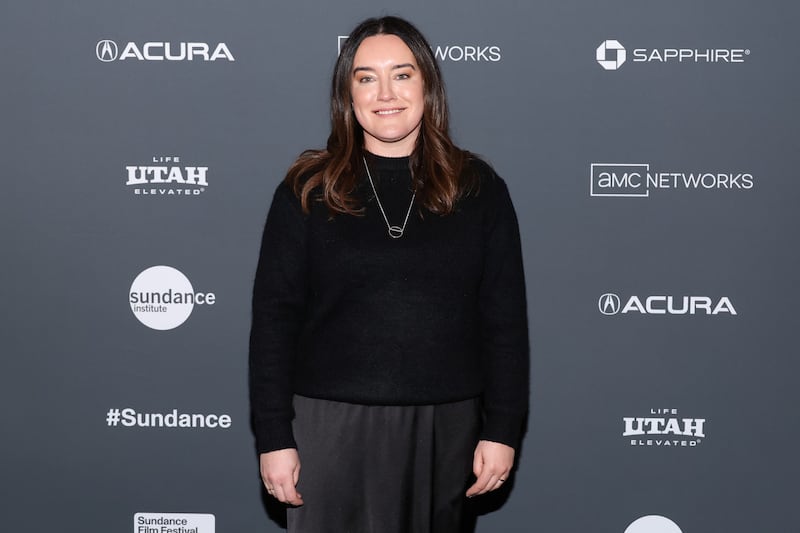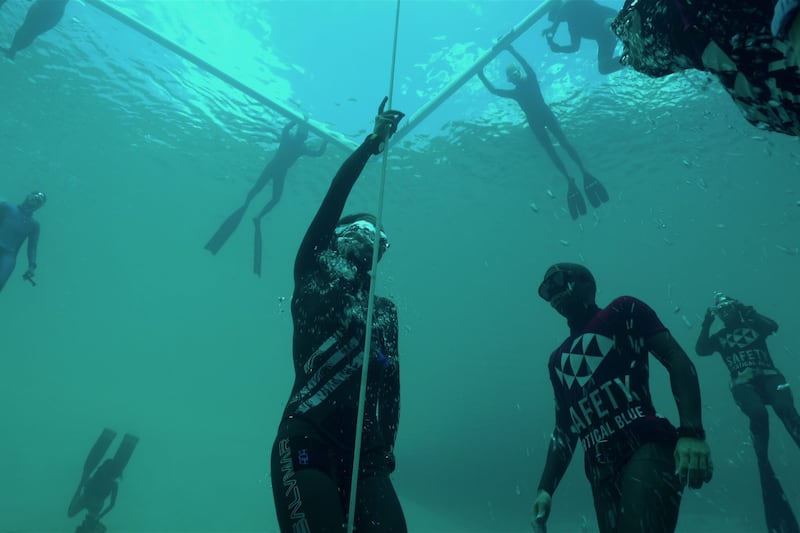In 2017, film-maker Laura McGann happened upon a news story about a freediving accident off the Red Sea resort of Dahab. The director of the Irish roller derby documentary Revolutions was immediately intrigued.
“I didn’t know anything about freediving,” says McGann. “I came across an article. It might have been in The Irish Times. The first thing I did is what I suppose anyone would do: I googled ‘What is freediving?’ And that brought me into this beautiful world of videos of people who look like dolphins. And I was doing what I hope people do when they watch the film. I started holding my breath and I had to breathe seven times before this person had finished their dive. I love Blue Planet. I love adventure docs. But this was like nothing I’d ever seen.”
Freediving, also known as breath-hold diving, is a form of underwater diving in which divers rely on their lungs rather than breathing apparatus. Practitioners hold their breath for more than three minutes while traversing more than 100m and more downwards. Branko Petrović, a Guinness World Record holder, has scored several record attempts over 10 minutes. Somewhere around the 30m mark, the body loses buoyancy and begins to sink. Drowning is an obvious risk. The ocean’s pressure can result in a “shallow-water blackout”, wherein the diver loses consciousness during the ascent to the surface. It takes a particularly focused kind of athlete.
The pioneering Russian freediver Natalia Molchanova disappeared without a trace while diving around the Balearic islands in 2015.
READ MORE
“Nobody wakes up in the morning and says: Guys, I’m going to dive 100m down into the ocean,” says McGann. “They do it bit by bit. They mitigate risks. They’re aware of the risks and they know how to keep themselves safe. They don’t have to survive alone. They surround themselves with a team who will help them. They’re a very safety-conscious bunch of people. The safety diver is the boss. Everyone does whatever he or she says. Everybody wants to go home and have their dinner in the evening.”
McGann’s The Deepest Breath, her remarkable second feature, concerns the bond between the promising young Italian freediver Alessia Zecchini and her Irish safety diver, Steven Keenan. McGann builds the film around these two parallel lives and the mysterious – possibly romantic – bond between Keenan and Zecchini.
“Initially, looking at these people doing amazing things and looking relaxed while they did them pulled me in,” says the filmmaker. “And then, of course, finding all the different pieces of archive that were available. But as I learned more about Steven and Alessia, my real connection with the story started to grow.”
The photogenic and driven Alessia Zecchini wanted to be a freediver since she was a young teenager. By 15 she was attending rallies with the national team, but could not compete at national events due to her young age. Aged 21, with her sights on the famous Russian freediver Natalia Molchanova, Zecchini broke two world records, at the Indoor World Championship in Kazan and the Outdoor Italian Championship. She has subsequently set more than 30 more international records, including the coveted Constant Weight discipline (at 123m). She even has an asteroid – Asteroid 300124 Alessiazecchini – named in her honour. Throughout McGann’s thrilling new chronicle, Zecchini faces fierce competition from the equally ambitious Japanese freediver Hankao Hirose. She holds her breath for three minutes and 21 seconds during a freediving world record attempt in the film’s nerve-racking opening scene.
“What I loved about Alessia is that she was a 13-year-old girl with a burning passion,” says the director. “I had my own little dreams when I was a 13-year-old and I just admired how, through thick and thin, she kept moving forward. She clung to that dream. I thought that was beautiful.”

Stephen Keenan was an adventurer who broke various Irish freediving records before finding his purpose at “the last quiet place on Earth”. Settling down among the diving community at the Egyptian diving mecca of Dahab, home to the deadly underwater sinkhole known as the Blue Hole, Keenan became a trusted safety diver to the sport’s elite competitors.
In 2013 he saved the life of Natalia Molchanova’s son Alexey, the men’s Constant Weight world record holder, when the Russian blacked out at a competition in Greece. His loyalty and dedication are articulated through the terrible incident, which frames McGann’s documentary. Fellow freediver and friend Kristof Coenen describes how Keenan had been monitoring Molchanov from a 30m depth long enough to experience dangerous contractions. When he realised that Molchanov was in difficulties further down, Keenan made a “split-second decision: save Alexey or save himself?”
In 2017, Zecchini was hoping to conquer the Blue Hole’s underwater arch, which lies 55m below the surface, without fins. She would have become the first woman to do so since Natalia Molchanova. Keenan, once again, came to the rescue.
Her stunningly photographed underwater venture is punctuated by testimonies from Zecchini and Keenan’s respective fathers, Enzo and Peter.
Everybody wanted to make this film. Alessia had heard about the project and wanted to be involved before I even approached her
— Laura McGann
“I developed the project for a bit myself,” says McGann. “I started during Covid, so I was on Zoom with people worldwide and everybody had loads of time. I reached out to some friends and to Jamie D’Alton at Motive Pictures. I was living in Dún Laoghaire at the time and it just so happened that Jamie was living down the road from me; and Peter, Steven’s father, was living across the road from me. Which I didn’t know. Once he came on board, his seal of approval did all the work for me. Everybody wanted to make this film. Alessia had heard about the project and wanted to be involved before I even approached her. ”
The Deepest Breath, which premiered at Sundance last January, is already part of the 2024 awards conversation. Many reviews have evoked Free Solo, Elizabeth Chai Vasarhelyi and Jimmy Chin’s nail-biting Oscar-winning account of rock climber Alex Honnold’s quest to climb El Capitan in Yosemite National Park in June 2017, a feat undertaken without ropes or protective equipment. A closer comparison might be Fire of Love, last year’s compelling portrait of volcanologists Katia and Maurice Krafft. That film, in common with McGann’s, is defined by archival treasures.
“It was really about putting feelers out into the freediving community,” says the Kildare-born filmmaker. “We’d have maybe one photo from a particular event, but there’s a girl in the background with a GoPro camera. Who is she and where can we find her? We always wanted footage from the day. We’d take a grainy picture from the da over any kind of recon. We were lucky to have representation from every scene but we had to fill in the gaps. It was wonderful to be able to create that dramatic element from existing footage.”
I can swim all right. I’m a Greystones girl. I can tread water. I’m comfortable in the sea. But I was in the Caribbean and it’s 80m deep and there’s a bull shark. The currents were strong. So they gave me a noodle. I was in the water for eight hours that day
— Laura McGann
McGann and her cinematographer, Tim Cragg, were assisted by a school of divers with cameras and dozens of spectacular locations.
The filmmaker, who previously shot repeal documentary The 8th, is a keen swimmer and worked as a camera operator on The Odyssey for the National Geographic Channel. During the production of The Deepest Breath, however, she was literally and figuratively out of her depth in aquanautical terms.
“I can swim all right,” she says. “I’m a Greystones girl. I can tread water. I’m comfortable in the sea. But I was in the Caribbean and it’s 80m deep and there’s a bull shark – that I didn’t know about – and all these freedivers around me. The currents were strong. So they gave me a noodle. I was in the water for eight hours that day. With my noodle.”

“We filmed in the Blue Hole in Egypt, we filmed in the Bahamas, we filmed in Mexico; we filmed in snow caves,” says McGann. “Out at sea, I had a fleet of freediving filmmakers filming at 30m. They’d come back up and show me the shot and I’d say, ‘That’s really good. Can you do that one more time?’ And they’d go down. It was like working with seals. It was almost a supernatural experience.”
The Deepest Breath was co-produced by the hitmaking US imprint A24, and was snapped up by Netflix after its Sundance premiere. McGann suggests that this early success – not to mention a list of locations to rival any James Bond movie – is largely down to the involvement of John Battsek, the Oscar-winning producer behind Searching for Sugarman and One Day in September.
“He’s the godfather of documentary films,” says McGann. “I’ve been at events taking notes while he talks on stage. And now I had to work with this person. How was I even going to form a sentence? As far as I was concerned, he was up here and I was down there, so I had to get over that. Having A24 on board was an opportunity to really make an incredible film alongside these producers and editors who have made films that I adore.”
The Deepest Breath is in cinemas from July 14th and on Netflix from July 19th






















